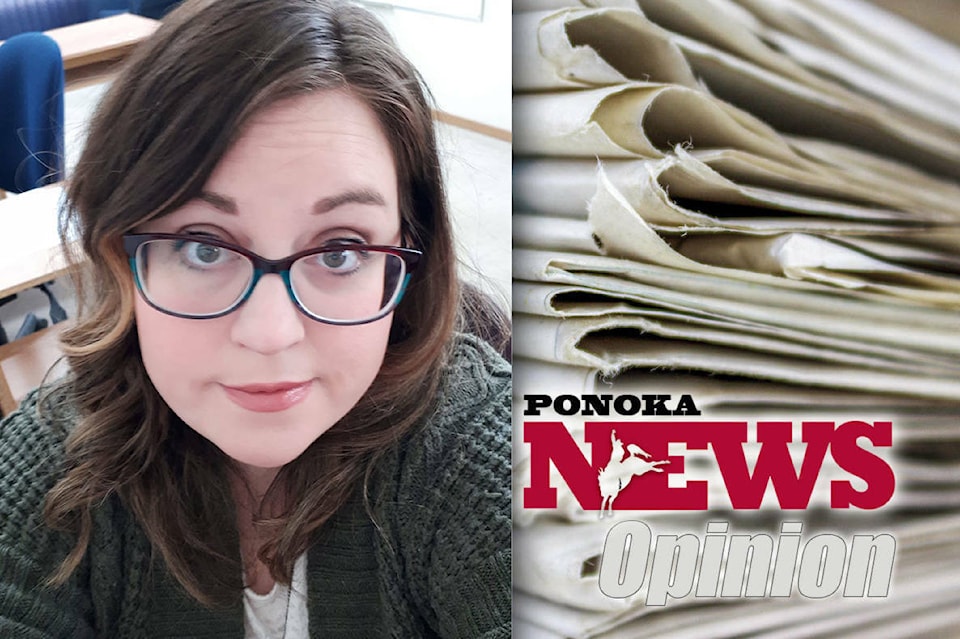While helicopters whirred overhead patrolling in the overcast sky, a bell tolled sonorously in the distance and intermittent cheering could be heard in the drawn-out, taut moments awaiting the arrival of His Holiness Pope Francis to the Ermineskin Cemetery July 25.
A small army of experienced, veteran reporters and photographers stood at the ready, lenses aimed with one eye closed as they chose their line of sight in anticipation of his arrival. You had but a mere few minutes to get it right, to get your shot — a moment of history frozen in time as the Pope prayed among neat rows of white crosses, lovingly embellished with hand-painted feathers and other colourful accents to honour those buried there.
The Chiefs of the Four Nations of Maskwacis accompanying the Pope down the road from the old residential school site, where symbolic teepees had been erected for the occasion, was perhaps one of the most significant aspects of the visit up to that point, however, there was no pause for photographers to capture the moment; the procession had to keep moving to Maskwa Park where the main purpose of the penitentiary pilgrimage was to take place: the public apology for the Catholic Church’s role in the residential school system in Canada.
Media from all over the world travelled to Alberta to cover the Pope’s visit to Maskwacis, and all had to go through an accreditation process. Of those, a handful were chosen for limited media pools to attend events in Maskwacis. In order to attend the events, all media had to report to a media centre set up in Edmonton at 5 a.m. After going through a security check that included walking through metal detectors and opening all bags and removing food for an RCMP canine unit to inspect, media boarded specific charter buses based on what media pools they had been approved for.
From a media coverage, security and organizational perspective, the event was compared to that of a G8 summit. In other words, it was massive, and professionally speaking, a bit daunting and nerve-wracking at first. And while a Papal visit usually takes 18 months to plan, this one had been brought together in four months, however, everything proceeded like a well-oiled machine.
While us media may have grumbled about the inconvenience of needing to travel to Edmonton for the security check and boarding the media bus so early, really, we were being graciously afforded the privilege to see and bear witness to such a once-in-a-lifetime event.
And once-in-a-lifetime it was.
There have only been three former papal visits to Canada, all by John Paul II. Not only Pope Francis’ first time to Canada, it was for the historic purpose of giving an apology on Indigenous territory in Canada, where the harms were inflicted.
Ste. Anne’s residential school survivor and advocate Evelyn Korkmaz said she’d waited for 50 years to hear the words “I’m sorry.” For others, the waiting continues as calls for real action and steps towards true reconciliation continue to sound out.
While many Indigenous Peoples living in Canada have commented on the apology, with a wide spectrum of reactions, one undeniable fact is that such an event has been long-awaited, and may never be repeated in the same way again. And it happened here.
Professionally speaking, covering such an important, momentous occasion, with live, on-the-scene updates, was exhilarating in the challenge it presented. The sense of being in the midst of an elite group of seasoned, high calibre journalists was also a bit thrilling and inspiring.
Personally, it was sobering and I was cognizant of the honour of being there, at that time, to make a record, and humbled to know I had no part in the proceedings beyond that.
The event was for survivors and the organizers wished the focus to remain on that and for the event to not be politicized. It wasn’t about me or any of my thoughts or feelings. I was there to report and that was all.
Knowing what I was seeing was unique to these fleeting moments, I try to engrave them in my memory: An older Indigenous woman gripping a friend in a tight embrace, a cigarette in her right hand; the heart-rendering, tortured expression on SiPihKo’s face as she sang out her outrage, pain and grief in her haunting, impromptu song. Certain parts stood out starkly during the press conference that followed with Chiefs and survivors:
- The Pope got to apologize in his own language, but I can’t speak mine, said one Chief who wasn’t taught Cree and like so many others is trying to regain that part of his identity now.
- Some residential schools in Alberta had electric chairs, which constitutes torture. Others had incinerators.
- It was kidnapping and rape. Charges should be laid.
As far as the impact of the visit and the apology, the only real opinions that matter are those of residential school survivors who are now grappling with the ramifications of the visit and all it may have meant, or not meant, to each of them individually.
Even so, witnessing the event will leave its own indelible mark on me, and inform the kind of journalist I become and the kind of person I want to be.
